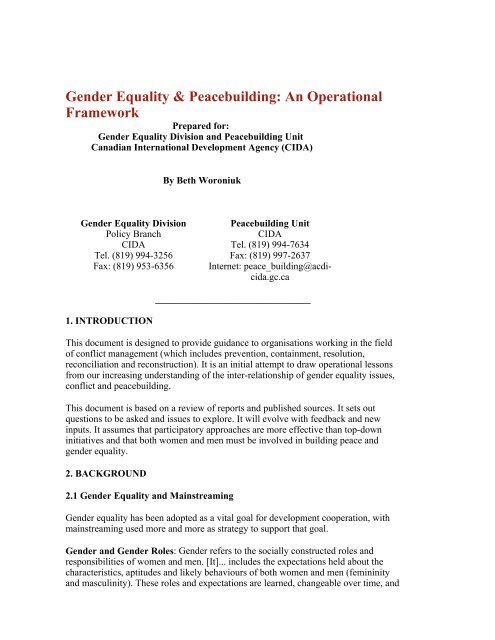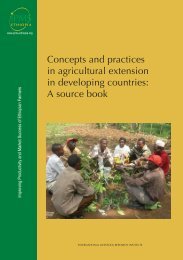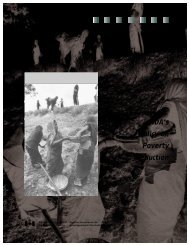Gender Equality & Peacebuilding: An Operational Framework
Gender Equality & Peacebuilding: An Operational Framework
Gender Equality & Peacebuilding: An Operational Framework
You also want an ePaper? Increase the reach of your titles
YUMPU automatically turns print PDFs into web optimized ePapers that Google loves.
<strong>Gender</strong> <strong>Equality</strong> & <strong>Peacebuilding</strong>: <strong>An</strong> <strong>Operational</strong><strong>Framework</strong>Prepared for:<strong>Gender</strong> <strong>Equality</strong> Division and <strong>Peacebuilding</strong> UnitCanadian International Development Agency (CIDA)By Beth Woroniuk<strong>Gender</strong> <strong>Equality</strong> DivisionPolicy BranchCIDATel. (819) 994-3256Fax: (819) 953-6356<strong>Peacebuilding</strong> UnitCIDATel. (819) 994-7634Fax: (819) 997-2637Internet: peace_building@acdicida.gc.ca________________________________1. INTRODUCTIONThis document is designed to provide guidance to organisations working in the fieldof conflict management (which includes prevention, containment, resolution,reconciliation and reconstruction). It is an initial attempt to draw operational lessonsfrom our increasing understanding of the inter-relationship of gender equality issues,conflict and peacebuilding.This document is based on a review of reports and published sources. It sets outquestions to be asked and issues to explore. It will evolve with feedback and newinputs. It assumes that participatory approaches are more effective than top-downinitiatives and that both women and men must be involved in building peace andgender equality.2. BACKGROUND2.1 <strong>Gender</strong> <strong>Equality</strong> and Mainstreaming<strong>Gender</strong> equality has been adopted as a vital goal for development cooperation, withmainstreaming used more and more as strategy to support that goal.<strong>Gender</strong> and <strong>Gender</strong> Roles: <strong>Gender</strong> refers to the socially constructed roles andresponsibilities of women and men. [It]... includes the expectations held about thecharacteristics, aptitudes and likely behaviours of both women and men (femininityand masculinity). These roles and expectations are learned, changeable over time, and
variable within and between cultures. From CIDA's Policy on <strong>Gender</strong> <strong>Equality</strong>(1998).<strong>Gender</strong> equality requires equal enjoyment by women and men of socially-valuedgoods, opportunities, resources and rewards. <strong>Gender</strong> equality does not mean that menand women become the same, but that their opportunities and life chances are equal.The emphasis on gender equality and women's empowerment does not presume aparticular model of gender equality for all societies and cultures, but reflects aconcern that women and men have equal opportunities to make choices about whatgender equality means and work in partnership to achieve it.Because of current disparities, equal treatment of women and men is insufficient as astrategy for gender equality. Achieving gender equality will require changes ininstitutional practices and social relations through which disparities are reinforced andsustained. It also requires a strong voice for women in shaping their societies.Mainstreaming is a strategy to support the goal of gender equality. It has two generaldimensions:the integration of gender equality concerns into the analyses and formulation ofall policies, programmes and projects; andinitiatives to enable women as well as men to formulate and express their viewsand participate in decision-making across all development issues.<strong>Gender</strong>equality and mainstreaming definitions are from DAC Guidelines for <strong>Gender</strong><strong>Equality</strong> and Women's Empowerment in Development Cooperation, 1998.2.2 The Emergence of a New Form of <strong>Peacebuilding</strong>This framework is grounded in a broad definition of peacebuilding: <strong>Peacebuilding</strong>refers to those initiatives which foster and support sustainable structures andprocesses which strengthen the prospects for peaceful coexistence and decrease thelikelihood of the outbreak, reoccurrence or continuation of violent conflict. Thisprocess typically contains both immediate and longer term objectives... <strong>Peacebuilding</strong>is a two-fold process requiring both the deconstruction of the structures of violenceand the construction of the structures of peace. Kenneth Bush (1998). A Measure ofPeace: Peace and Conflict Assessment (PCIA) of Development Projects in ConflictZones. Working Paper No. 1. The <strong>Peacebuilding</strong> and Reconstruction ProgramInitiative & Evaluation Unit. IDRC: Ottawa.2.3 Why Look At <strong>Gender</strong> <strong>Equality</strong> Issues in <strong>Peacebuilding</strong> Initiatives?It is important to ensure that gender equality issues are taken into consideration inpeacebuilding initiatives because:<strong>Gender</strong> is a relevant dimension in peacebuilding. Conflict is a genderedactivity. There is a strong gender division of labour, women and men havedifferential access to resources (including power and decision-making) duringconflicts, and men and women experience conflict differently. This wasrecognized by the international community and highlighted in the finaldocument of the Fourth World Conference on Women (Beijing, 1995) the
Platform for Action (PFA): while entire communities suffer the consequencesof armed conflict and terrorism, women and girls are particularly affectedbecause of their status in society as well as their sex ( para 135).Women (as well as men) have a fundamental stake in building peacefulcommunities. Their contributions to peacebuilding should be encouraged andsupported (given women's economic and political marginalisation, they are notalways well-placed to play an effective role).Canada has a formal commitment to gender equality and, more specifically, hasagreed that a gender perspective should be part of peacebuilding initiatives (thePFA states: In addressing armed or other conflicts, an active and visible policyof mainstreaming a gender perspective into all policies and programmesshould be promoted so that before decisions are taken, an analysis is made ofthe effects on women and men, respectively. (para 141))peace is a prerequisite to achieve the goal of gender equality and women'sempowerment and some would argue that gender equality is necessary for truepeace (broadly defined).2.4 <strong>Gender</strong> Issues in Conflict SituationsEach conflict/peacebuilding situation is different and there is always a need for aspecific analysis. Factors such as gender, religion, age, class, nationality, ethnicity,race and sexual orientation will come together in different ways. Table 1 highlightsways gender differences and inequalities may be relevant in conflict situations. Thisis not a complete list, rather it provides examples and is intended to provokeadditional reflection.Table 1: Elements of Conflict Situations andPossible <strong>Gender</strong> DimensionsElements ofConflictSituationsPossible <strong>Gender</strong> DimensionsPre-Conflict SituationsIncreased mobilisationof soldiers.Increased commercial sex trade (including child prostitution)around military bases and army camps.Nationalist propagandaused to increase supportfor military action<strong>Gender</strong> stereotypes and specific definitions of masculinity andfemininity are often promoted. There may be increased pressureon men to 'defend the nation.'Mobilisation of propeaceactivists andorganisationsWomen have been active in peace movements – both generallyand in women-specific organisations. Women have often drawnmoral authority from their role as mothers. It has also beenpossible for women to protest from their position as mothers whenother forms of protest have not been permitted by authorities.Increasing human rightsviolationsWomen's rights are not always recognized as human rights.<strong>Gender</strong>-based violence may increase.During conflict situations
Psychological trauma,physical violence,casualties and deathMen tend to be the primary soldiers/combatants. Yet, in variousconflicts, women have made up significant numbers ofcombatants.Women and girls are often victims of sexual violence (includingrape, sexual mutilation, sexual humiliation, forced prostitution andforced pregnancy) during times of armed conflict.Social networksdisrupted and destroyed-- changes in familystructures andcomposition<strong>Gender</strong> relations can be subject to stress and change. Thetraditional division of labour within a family may be underpressure. Survival strategies often necessitate changes in thegender division of labour. Women may become responsible for anincreased number of dependents.Mobilisation of peoplefor conflict. Everyday lifeand work disrupted.The gender division of labour in workplaces can change. Withmen's mobilisation for combat, women have often taken overtraditionally male occupations and responsibilities. Women havechallenged traditional gender stereotypes and roles by becomingcombatants and taking on other non-traditional roles.Material shortages(shortages of food,health care, water, fuel,etc)Women's role as provider of the everyday needs of the family maymean increased stress and work as basic goods are more difficultto locate. Girls may also face an increased workload. Noncombatantmen may also experience stress related to theirdomestic gender roles if they are expected, but unable, to providefor their families.Creation of refugeesand displaced peoplePeople's ability to respond to an emergency situation is influencedby whether they are male or female. Women and men refugees(as well as boys and girls) often have different needs andpriorities.Dialogue and peacenegotiationsWomen are often excluded from the formal discussions given theirlack of participation and access in pre-conflict decision-makingorganisations and institutions.During reconstruction and rehabilitationPolitical negotiationsand planning toimplement peaceaccordsMen's and women's participation in these processes tends to vary,with women often playing only minor roles in formal negotiationsor policy making.Media used tocommunicate messages( peace accords, etc.)Women's unequal access to media may mean that their interests,needs and perspectives are not represented and discussed.Use of outsideinvestigators,peacekeepers, etc.Officials are not generally trained in gender equality issues(women's rights as human rights, how to recognize and deal withgender-specific violence).Women and girls have been harassed and sexually assaulted bypeacekeepers.Holding of electionsWomen face specific obstacles in voting, in standing for electionand in having gender equality issues discussed as election issues.Intern'l investments inemployment creation,health care, etcReconstruction programmes may not recognize or give priority tosupporting women's and girls' health needs, domesticresponsibilities or needs for skills training and creditDemobilisation ofcombatantsCombatants often assumed to be all male. If priority is granted toyoung men, women do not benefit from land allocations, creditschemes, etc.
Measures to increasethe capacity of andconfidence in civilsociety.Women's participation in community organisations and NGOs isgenerally uneven. These organisations often lack the capacity andinterest in granting priority to equality issues.3 WHAT TO DO?What are the implications of our increasing understanding of both the genderdimensions of conflict and peacebuilding and the role of development assistance infacilitating peacebuilding processes? There are two fundamental dimensions:First, all initiatives should:incorporate a gender analysis into the assessment of the situation;ensure that gender equality considerations are present at the level of results (inother words, gender equality issues should not be restricted to one componentof a project, rather they should be part of and influence the primary direction ofthe initiative);increase women's participation in conflict resolution at decision-making levels;promote women as actors and protagonists (rather than a 'vulnerable group');andprovide, where feasible, sex-disaggregated data (of participants, beneficiaries,etc.).Second, there is also a need for specific initiatives to strengthen women's capacity toparticipate in peacebuilding initiatives in a meaningful fashion, to improve thecapacity of organisations to deal with gender differences and inequalities and toreduce gender inequalities. This could involve initiatives and/or components thatdirectly target women (including skills training, capacity and development forwomen's organisations) and/or men (such as sensitisation and analysis of linksbetween notions of masculinity and violence).3.1 <strong>Gender</strong> analysis in peacebuilding initiativesIn recent years significant work has been done in developing gender frameworks andanalytical tools. Table 2 below distills some of this thinking into questions to beasked in peacebuilding initiatives.In order to be most effective, the questions should not be asked in a mechanisticmanner. They are meant to spark discussion and action on how best to incorporate agender equality perspective and improve peacebuilding initiatives.Table 2: <strong>Gender</strong> <strong>An</strong>alysis in <strong>Peacebuilding</strong>InitiativesKey questions to askHow and why is gender equalityrelevant to the proposedresults/impacts of the project?Why ask this questionAll too often gender equality issues are consideredas a sub-set or a marginal issue. Experience hasshown that it is important to bring equality issues into
...<strong>Peacebuilding</strong>: Challenges and Opportunities in Setting Performance Indicators.Prepared for the Strategic Planning Division of Policy Branch, CIDA., genderequality dimensions include:1) human security is enhanced: the initiative distinguishes between the security ofwomen and men (as well as boys and girls) and ensures that everyone's security isenhanced;2) increased capacity of local leadership to assume responsibility for peace: localleadership includes both women and men; local leadership has the capacity torecognize needs and potential participation of both women and men;3) civil society is empowered: women are active participants in civil societyorganisations, organisations represent both their female and male members; vibrantwomen's organisations and other equality-seeking organisations are active in settingpolicy agendas;4) increase trust in and reliance on as well as capacity to function of political andlegal systems: legal systems based on and promote women's rights; both women andmen have trust in political and legal systems; increased participation of women inpolitical system;5) society is demilitarized and war economies are converted: both women and menbenefit from economic promotion initiatives; demilitarisation is ensured at all levels(including the household).A similar analysis could be carried out for other primary expected results.3.4 IndicatorsIn general, sex-disaggregated indicators can offer some indications of the differentialimpact of initiatives on women and men. For example, asking how many peacenegotiators were women or the voting rates of women and men or the male/femaleratio of a group of displaced people can offer insights into gender differences and thevarying impact of a project on women and men.Indicators of more equal gender relations and women's increased role is setting apeacebuilding agenda are more difficult to frame. In part, they will be situationspecificas they will relate to what each project is intending to achieve.However potential indicators could be based on:increased participation of women in peacebuilding;respect for women's human rights; institutions able to deal with women'scomplaints relating to human rights abuses;ratification and implementation of international agreements on women's rightsand empowerment;improved infant and maternal mortality figures;number of women standing for election and the number elected.; andpercentage of people starting new businesses which are women.
A third set of indicators offer guidance on whether or not attention has been given togender equality considerations in specific projects. These include:expected results include a gender equality dimension;resources are provided to ensure that the gender equality dimension is deliveredduring the implementation phase; andthe implementing organisations have a demonstrated capacity to work withequality issues.Table 3: Entry Points to Support <strong>Gender</strong> <strong>Equality</strong> in <strong>Peacebuilding</strong>Institutional Capacity to Manage/Resolve Conflict and Build Peace:Support for women's role in peacebuilding: What is the role of both women in mixed organisationsand women's organisations in peacebuilding initiatives -- both formally and informally? (Even whenwomen have been excluded from the formal discussions, they have often played an important rolethrough civil society institutions in trying to hold governments accountable for their commitments.)Are women involved in early warning systems? Do women, as well as men, receive training inmediation, facilitation and alternative dispute resolution? Is there an analysis of the barriers thatwomen face when attempting to participate in peacebuilding initiatives? Is there a role for womenspecificactivities?Institutional capacity to work with a gender equality perspective: Do local and internationalorganisations have the capacity to recognize and work with gender equality issues? For example,do investigators of war crimes take full consideration of gender- based violence and do witnessprotection programmes consider the safety or witnesses testifying in cases relating to genderbasedviolence? Do organisations working with refugees have the capacity to implement theUNHCR guidelines on refugee women? Do Canadian organisations providing support andassistance have the capacity to work with gender issues?Human Security:Individual security: Are the basic physical security needs of women and girls being met? Is there arecognition that women and girls face specific dangers primarily related to their sex? Is there aconsideration of women's sense and definition of security? (Specific issues for attention includeviolence against women and girl refugees, prostitution, gender-based violence, rape, etc.) Inaddressing basic human needs and survival strategies, is there consideration of needs of bothwomen and men (based on their health needs and domestic roles and responsibilities)?Public and state security: Do public security forces receive adequate training on women's rightsand violence against women? Do women have equal access to employment in public securityforces? Do they have equal access to membership in civilian review boards? Do oversightinstitutions (ombudsmen, complaints boards etc.) have the mandate and authority to investigateviolations of women's rights related to the conflict?Political Structures and Processes:
Women's involvement: Will the project support women's participation and decision-making withinpolitical structures, organisations and other institutions? Will non-governmental organisations gaininsight into how better to represent their female members? Will women's organisations gain newskills and capacity in articulating policy alternatives, holding governments accountable and beingadvocates for change?Human rights: Do all human rights initiatives recognize and support women's rights as humanrights? Legal framework: Special support can be directed to ensuring that the legal systemcomplies with international norms and conventions on women's legal and human rights (includingCEDAW and the Beijing Platform for Action) Women within state structures: Will women haveequal access to state employment and advancement at all levels?Economic Structures and Processes:Economic reconstruction: Do reconstruction programmes allow for equitable participation bywomen? Are these programmes designed so that women can take advantage of new resourcesand/or opportunities? Will women's productive roles be supported by these programmes?Social Reconstruction and Empowerment:Support the gains women might have made: In some conflict situations, women might have movedinto non-traditional occupations or made other gains. Development assistance can play a role inhelping ensure that there is no movement back. Support can be provided to women's organisationsand efforts can be made to grant legitimacy to these new roles.Women's empowerment: Is there support for women's empowerment generally (as defined byinternational conventions (including the Convention on the Elimination of All forms of DiscriminationAgainst Women - CEDAW) and the Beijing Platform for Action)? Do projects anticipate and attemptto minimize backlash?4. REFERENCES AND RESOURCES4.1 Background DocumentsBRIDGE (1996). <strong>Gender</strong>, emergencies and humanitarian assistance. Commissionedby WID desk, European Commission, Directorate General for Development.BRIDGE (1996). <strong>Gender</strong>, conflict and development. Volume 1: Overview; Volume 2:Case Studies. Reports No. 34 & 35. Prepared for the Netherlands' Special Programmeon WID, Ministry of Foreign Affairs.Canadian <strong>Peacebuilding</strong> Coordinating Committee (1998). <strong>Gender</strong> and <strong>Peacebuilding</strong>:A Discussion Paper.Date-Bah, E.(1996). Sustainable Peace After War: Arguing the Need for MajorIntegration of <strong>Gender</strong> Perspectives in Post-Conflict Programming. ActionProgramme on Skills and Entrepreneurship Training for Countries Emerging From
Armed Conflict, ILO.Grenier, S. (1997). Bibliography on the Rights of Women in Situations of Conflict.International Centre for Human Rights and Democratic Development. Montreal.Manning, K. and B. Arneil (1997). Engendering <strong>Peacebuilding</strong>. March. Departmentof Foreign Affairs and International TradeNordstrom, C.(1997). Girls and Warzones: Troubling Questions. Life & PeaceInstitute: Uppsala.Sorensen, B. (1998). Women and Post-Conflict Reconstruction: Issues and Sources.The War-Torn Societies Project, Occasional Paper No. 3. UNRISD.Sida. (1997). Overview: <strong>Gender</strong> <strong>Equality</strong> and Emergency Assistance/ConflictResolution. StockholmUNESCO (1997). Expert Group Meeting on Male Roles and Masculinities in thePerspective of a Culture of Peace. Oslo, 24-28 September.Women's Rights Unit, United Nations Division for the Advancement of Women.(1998) Sexual Violence and Armed Conflict: United Nations Response. Women2000. April.4.2 International Agreements and GuidelinesBeijing Platform for Action: Critical Area of Concern: Women and ArmedConflict. Strategic Objectives:E.1 - Increase the participation of women in conflict resolution at decision-makinglevels and protect women living in situations of armed and other conflicts or underforeign occupation.E.4 - Promote women's contribution to fostering a culture of peace.E.5 - Provide protection, assistance and training to refugee women, other displacedwomen in need of international protection and internally displaced women.Full text available at:http://www.un.org/womenwatch/daw/beijing/platform/armed.htmThe Vienna Declaration and Programme of Action (1993). Article 38: Violationsof the human rights of women in situations of armed conflict are violations of thefundamental principles of international human rights and humanitarian law." Forcomplete text see:http://www.unhchr.ch/html/menu5/wchr.htmDeclaration on the Protection of Women and Children in Emergency and ArmedConflict (1974). Available at:http://www.unhchr.ch/html/menu3/b/24.htm
...UNHCR (1995). Sexual Violence Against Refugees: Guidelines on Preventionand Response. Geneva.UNHCR (1991). Guidelines on the Protection of Refugee Women. Geneva._______________________________________________This document has been prepared by CIDA's <strong>Peacebuilding</strong> Unit (MultilateralPrograms Branch) and CIDA's <strong>Gender</strong> <strong>Equality</strong> Unit (Policy Branch) with thesupport of Beth Woroniuk (GGI) - April 1999Comments and feedback are welcome. Please contact: peace_building@acdicida.gc.ca





